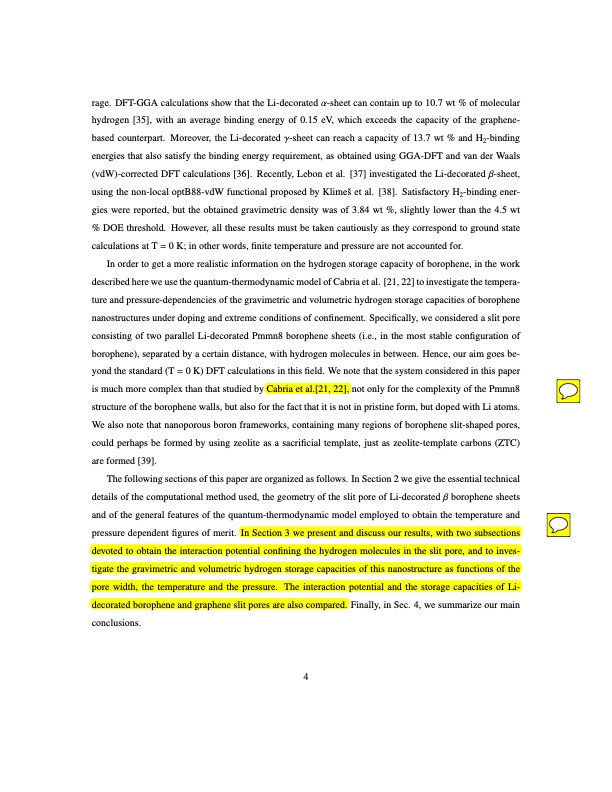
PDF Publication Title:
Text from PDF Page: 006
rage. DFT-GGA calculations show that the Li-decorated α-sheet can contain up to 10.7 wt % of molecular hydrogen [35], with an average binding energy of 0.15 eV, which exceeds the capacity of the graphene- based counterpart. Moreover, the Li-decorated γ-sheet can reach a capacity of 13.7 wt % and H2-binding energies that also satisfy the binding energy requirement, as obtained using GGA-DFT and van der Waals (vdW)-corrected DFT calculations [36]. Recently, Lebon et al. [37] investigated the Li-decorated β-sheet, using the non-local optB88-vdW functional proposed by Klimesˇ et al. [38]. Satisfactory H2-binding ener- gies were reported, but the obtained gravimetric density was of 3.84 wt %, slightly lower than the 4.5 wt % DOE threshold. However, all these results must be taken cautiously as they correspond to ground state calculations at T = 0 K; in other words, finite temperature and pressure are not accounted for. In order to get a more realistic information on the hydrogen storage capacity of borophene, in the work described here we use the quantum-thermodynamic model of Cabria et al. [21, 22] to investigate the tempera- ture and pressure-dependencies of the gravimetric and volumetric hydrogen storage capacities of borophene nanostructures under doping and extreme conditions of confinement. Specifically, we considered a slit pore consisting of two parallel Li-decorated Pmmn8 borophene sheets (i.e., in the most stable configuration of borophene), separated by a certain distance, with hydrogen molecules in between. Hence, our aim goes be- yond the standard (T = 0 K) DFT calculations in this field. We note that the system considered in this paper is much more complex than that studied by Cabria et al.[21, 22], not only for the complexity of the Pmmn8 structure of the borophene walls, but also for the fact that it is not in pristine form, but doped with Li atoms. We also note that nanoporous boron frameworks, containing many regions of borophene slit-shaped pores, could perhaps be formed by using zeolite as a sacrificial template, just as zeolite-template carbons (ZTC) are formed [39]. The following sections of this paper are organized as follows. In Section 2 we give the essential technical details of the computational method used, the geometry of the slit pore of Li-decorated β borophene sheets and of the general features of the quantum-thermodynamic model employed to obtain the temperature and pressure dependent figures of merit. In Section 3 we present and discuss our results, with two subsections devoted to obtain the interaction potential confining the hydrogen molecules in the slit pore, and to inves- tigate the gravimetric and volumetric hydrogen storage capacities of this nanostructure as functions of the pore width, the temperature and the pressure. The interaction potential and the storage capacities of Li- decorated borophene and graphene slit pores are also compared. Finally, in Sec. 4, we summarize our main conclusions. 4PDF Image | Hydrogen storage capacity of Li-decorated borophene

PDF Search Title:
Hydrogen storage capacity of Li-decorated boropheneOriginal File Name Searched:
APSUSC-D-20-15170.pdfDIY PDF Search: Google It | Yahoo | Bing
CO2 Organic Rankine Cycle Experimenter Platform The supercritical CO2 phase change system is both a heat pump and organic rankine cycle which can be used for those purposes and as a supercritical extractor for advanced subcritical and supercritical extraction technology. Uses include producing nanoparticles, precious metal CO2 extraction, lithium battery recycling, and other applications... More Info
Heat Pumps CO2 ORC Heat Pump System Platform More Info
| CONTACT TEL: 608-238-6001 Email: greg@infinityturbine.com | RSS | AMP |